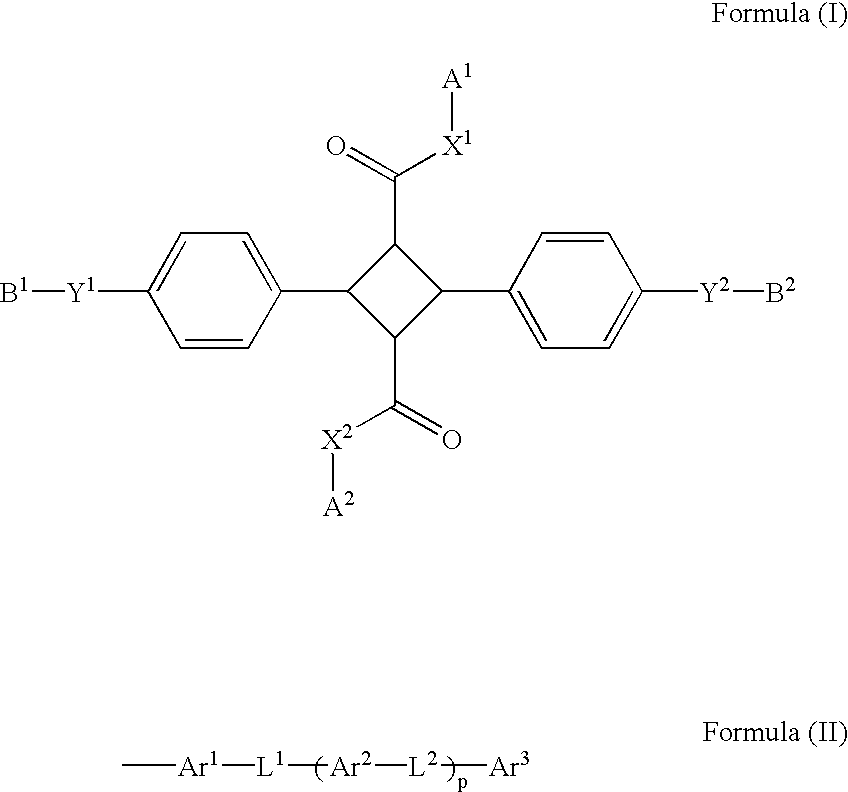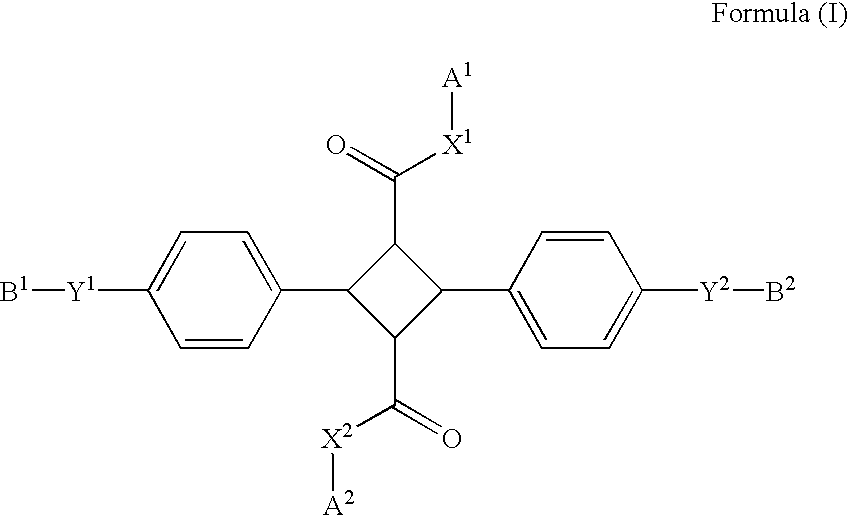4-Membered ring compound and optical phase optical retardation plate using the same
- Summary
- Abstract
- Description
- Claims
- Application Information
AI Technical Summary
Problems solved by technology
Method used
Image
Examples
example 1
Synthesis of Compound 1
[0060] (1.alpha.,2.alpha.,3.beta.,4.beta.)-2,4-Bis(4-hydroxyphenyl)-1,3-cy-clobutan e-dicarboxylic acid (3.28 g) was dissolved in 25 mL of dimethylacetamide and added with 6.9 g of potassium carbonate, 5.48 g of 1-butyl bromide and 600 mg of sodium iodide. After stirred at 100.degree. C. for 5 hours, the mixture was added with water and extracted with hexane. The extract was dried over anhydrous sodium sulfate and then concentrated under reduced pressure. The obtained residue was added with 50 mL of tetrahydrofuran, 50 mL of ethanol and 1 mol / L (1 N) sodium hydroxide aqueous solution and stirred for three days under a reflux condition. The reaction mixture was added with water, washed with hexane and added with hydrochloric acid to obtain precipitates. The obtained precipitates were collected and recrystallized from acetonitrile to obtain 3.22 g of (1.alpha.,2.alpha.,3.beta.,4.beta.)-2,4-bis(4-butoxyphen-yl)-1,3-cyclobutane-dicar boxylic acid.
[0061] Then, 440 ...
example 2
Synthesis of Compound 2
[0064] (1.alpha.,2.alpha.,3.beta.,4.beta.)-2,4-Bis(4-hydroxyphenyl)-1,3-cy-clobutan e-dicarboxylic acid (9.7 g) was dissolved in 200 mL dimethylformamide, added with 17.9 g of methyl paratoluenesulfonate and stirred at 40.degree. C. for 16 hours. The reaction mixture was added with water, and the obtained solid was taken by filtration to obtain 4.6 g of dimethyl (1.alpha.,2.alpha.,3.beta.,4.beta.)-2,4-bis(4-hydroxyphenyl-)-1,3-cyclobutane-dica rboxylate. The dimethyl (1.alpha.,2.alpha.,3.beta.,-4.beta.)-2,4-bis(4-hydroxyphenyl)-1,3-cyclobutane-dica rboxylate (710 mg) was dissolved in 15 mL of the mixture of dimethylformamide and tetrahydrofuran, added with 600 mg of sodium iodide, 1.38 g of potassium carbonate and 770 mg of 1-octyl bromide and stirred at 80.degree. C. for 7 hours. The reaction mixture was added to water and extracted with ethyl acetate. The organic layer was washed with water, then dried over sodium sulfate and concentrated under reduced press...
example 3
Synthesis of Compound 3
[0068] Compound 3 was synthesized according to the method of Example 2 except that the 1-octyl bromide used in Example 2 was replaced with 1-dodecyl bromide.
[0069] FAB-MS (M+H).sup.+=1015
[0070] .sup.1H-NMR (CDCl.sub.3, .delta.): 0.88 (t, 6H), 1.2-1.5 (m, 36H), 1.73 (quintet, 4H), 3.8-3.9 (m, 6H), 4.6-4.7 (m, 2H), 6.78 (s, 2H), 6.84 (d, 4H), 7.10 (d, 4H), 7.2-7.4 (m, 14H), 7.5-7.6 (m, 4H)
PUM
| Property | Measurement | Unit |
|---|---|---|
| Length | aaaaa | aaaaa |
| Length | aaaaa | aaaaa |
| Percent by mass | aaaaa | aaaaa |
Abstract
Description
Claims
Application Information
 Login to View More
Login to View More - R&D
- Intellectual Property
- Life Sciences
- Materials
- Tech Scout
- Unparalleled Data Quality
- Higher Quality Content
- 60% Fewer Hallucinations
Browse by: Latest US Patents, China's latest patents, Technical Efficacy Thesaurus, Application Domain, Technology Topic, Popular Technical Reports.
© 2025 PatSnap. All rights reserved.Legal|Privacy policy|Modern Slavery Act Transparency Statement|Sitemap|About US| Contact US: help@patsnap.com



